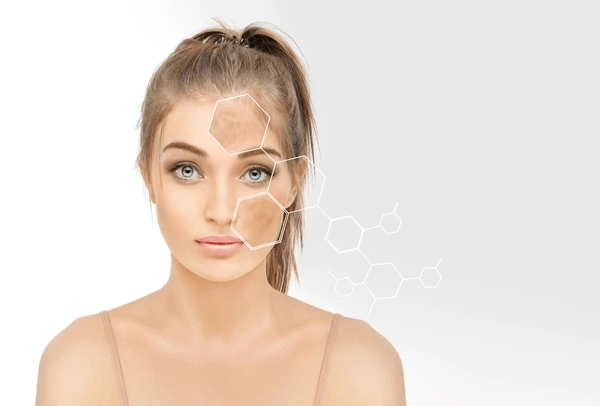
About
Melasma
Struggling with brown patches or melasma? At The Velvet Skin Centre, Indira Nagar, Lucknow, our skin doctor offers advanced pigmentation treatments for clear, radiant skin.
Book Appointment NowCall to book Appointment +91 8002558860

About
Struggling with brown patches or melasma? At The Velvet Skin Centre, Indira Nagar, Lucknow, our skin doctor offers advanced pigmentation treatments for clear, radiant skin.
Book Appointment Now
Melasma is a common skin problem. The condition causes dark, discoloured patches on your skin.
It's also named chloasma, or the "mask of pregnancy," when it appears in pregnant women. The situation is much more familiar in females than males, though males can get it too. According to the American Academy of Dermatology, ninety per cent of people who develop melasma are women.

Dr. Asma provides advanced solutions for melasma treatment in Lucknow at The Velvet Skin Centre, Indira Nagar. Melasma causes dark patches on the face, often triggered by sun exposure or hormones. Our treatments include chemical peels, laser therapy, and medical-grade creams that restore skin brightness and clarity. Patients achieve even-toned, radiant skin with safe and effective dermatological care.
Melasma has two leading causes: radiation, ultraviolet, visible light, infrared (heat) light, and hormones.
Ultraviolet and infrared radiation from the sun is critical in making melasma worse. Additional potential causes of melasma have:
Melasma causes patches of discolouration. The patches are darker compared to your usual skin colour. It commonly appears symmetrical on the face, with matching patterns on both sides. Other areas of your body often exposed to the sun can also develop melasma.
Brownish-coloured patches usually appear on the following:
It can even occur on the neck and forearms. Skin discolouration doesn't do any physical damage, but you might feel self-conscious about how it looks.
If you detect these signs of melasma, see your healthcare skill. They might refer you to a dermatologist specializing in treating skin disorders.
A visible exam of the affected area is usually adequate to diagnose melasma. However, to rule out specific causes, your healthcare professional might also conduct some tests.
One testing process is a Wood's lamp test. This particular kind of light is held up to your skin. It allows your healthcare specialist to check for bacterial and fungal disorders and determine how multiple layers of skin the melasma affects. They power also perform a biopsy to check for any severe skin conditions. It involves removing a small piece of the affected skin for testing.
Melasma may go away on its own. It usually happens when a trigger, such as pregnancy or a medication, causes melasma. For example, melasma can fade when you deliver your baby or stop taking the drug.
Melasma can even last for years or even a lifetime. So while melasma cannot damage your body, it's comprehensible that multiple people want to treat it.
If you like to treat melasma, ask your dermatologist about the cost of therapy. As therapy for melasma is not believed medically necessary, most insurers will not protect the price.
If you choose to treat melasma, your dermatologist will design a treatment plan tailored to your requirements. Your program will consider your skin tone, how deeply the melasma reaches your skin, and any triggers you may have. For example, sunlight, taking birth control pills, and even stress can trigger melasma.
The goals of treatment are to:
The treatment plan often consists of the following:
Sun safeness: Sunlight causes the skin to produce more pigment, which can darken melasma and generate new patches.
Your dermatologist will advise you on protecting your skin from the sun. It often involves wearing a wide-brimmed hat outdoors, seeking shade, and applying broad-spectrum sunscreen (SPF 30 or higher) throughout the day.
For patients who include melasma, dermatologists often advise using a sunscreen that provides for:
Medication and procedures: Your doctor may define a drug that can decrease the excess pigment in your skin. Most patients receive a prescription for medication they use for their skin at home.
Your dermatologist may prescribe one or more additional of the following:
When using makeup to hide melasma, applying everything is essential for the best results. Here's the order that dermatologists recommend:
1. Melasma medication
2. Sunscreen
3. Camouflage makeup
When you track your treatment plan, melasma can be stubborn. Some people still see melasma. Experimenters have been researching this problem, which has led to several therapy advances.
To enhance your results, your dermatologist may count one or better of the cult to your treatment plan:
Only a board-certified dermatologist should perform the above procedures. Getting the desired results requires in-depth knowledge of the skin. A board-certified dermatologist has the training to select the correct method for each patient, counsel you on what to expect, and perform the procedure safely.
About
About
With multiple skin and hair care clinics across Lucknow, including The Velvet Skin Centre led by Dr. Asma – the best skin doctor in Lucknow and a trusted hair specialist doctor in Lucknow – we make expert dermatological treatments easily accessible, ensuring you receive the best care close to home.
Phone: +91 8002558860
Phone: +91 8002558860
Phone: +91 8002558860

Copyright @ 2025 The Velvet Skin Centre All Rights Reserved